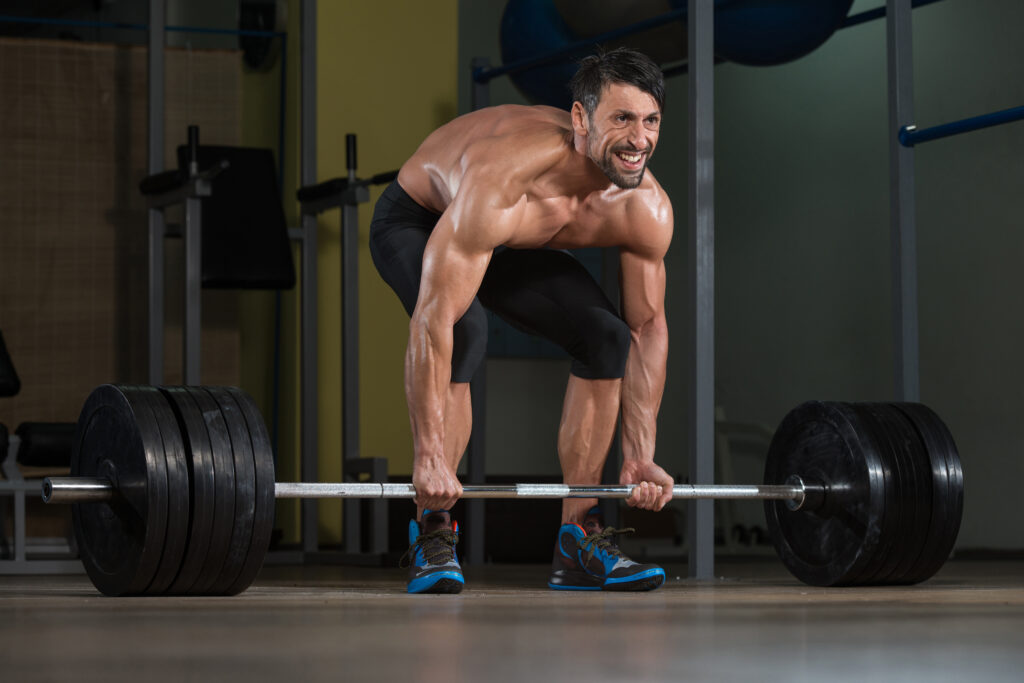
Male Fitness Athlete Lifting Deadlift In The Gym
What Are The Best Practices For Lifting To Avoid Lower Back Pain?
If you’ve ever experienced lower back pain from lifting, you know just how debilitating it can be. But fear not, because in this article, we’ll be discussing the best practices for lifting to avoid lower back pain. Whether you’re moving heavy boxes or just picking up your kids, these tips and techniques will help keep your back pain-free and strong. So let’s dive in and explore the strategies that can make a world of difference in your lifting routine.

Proper Body Mechanics
When it comes to lifting objects, maintaining proper body mechanics is crucial in order to avoid lower back pain. One of the key elements of proper body mechanics is to maintain a neutral spine. This means keeping your spine in its natural, slightly curved position rather than rounding or arching it. By doing so, you distribute the load evenly throughout your body and reduce the strain on your lower back.
Another important aspect of proper body mechanics is bending at the hips and knees. Instead of bending over from your waist, which puts unnecessary stress on your lower back, you should hinge forward at your hips and bend your knees to lower your body. This engages the strong muscles in your legs, particularly your quadriceps and hamstrings, and takes the pressure off your lower back.
Engaging the core muscles is essential for proper body mechanics as well. Your core includes not only your abdominal muscles but also your back muscles, pelvic floor, and diaphragm. Keeping these muscles activated and strong provides stability and support for your spine during lifting. Engaging your core also helps to maintain proper alignment and prevent excessive twisting or bending.
Warm Up and Stretch
Before you begin any lifting activity, it’s important to warm up your muscles and stretch to prepare them for the task at hand. Performing dynamic warm-up exercises, such as arm swings, leg swings, and light cardio, increases blood flow and raises your body temperature, helping to loosen up your muscles and reduce the risk of injury.
Stretching the hamstrings and hips is particularly beneficial for avoiding lower back pain when lifting. Tight hamstrings can contribute to improper body mechanics and strain on the lower back. By incorporating stretches for the hamstrings, such as standing toe touches or seated hamstring stretches, into your warm-up routine, you can improve their flexibility and relieve tension in the lower back.
Additionally, activating the glute muscles before lifting is important for optimal body mechanics. The glutes are the largest muscles in the body and play a major role in stabilizing the pelvis and supporting the lower back. Simple exercises like glute bridges or clamshells can be effective in activating these muscles and helping to prevent lower back pain.
Choose the Right Lifting Technique
Using the correct lifting technique is vital for protecting your lower back. One of the most important guidelines is to use your leg muscles to lift, rather than relying solely on your back muscles. This means pushing through your legs and using the strength of your quadriceps and hamstrings to lift the load, while keeping your back straight and your core engaged.
Keeping the load close to your body is another key element of proper lifting technique. Holding the object close to your body helps to minimize the strain on your lower back and provides better stability. Avoid reaching out or holding the load away from your body, as this can put unnecessary stress on your spine.
In addition, it’s crucial to avoid twisting or rotating your spine while lifting. Twisting motions can strain the muscles, ligaments, and discs in your lower back. Instead, pivot your entire body using your feet and keep your hips and shoulders facing the same direction as you lift and move the object.
Use Appropriate Equipment
Using the right equipment can significantly reduce the risk of lower back pain when lifting. Supportive footwear is essential, as it provides stability, cushioning, and arch support for your feet and ankles. Choose shoes that fit properly and offer ample shock absorption to minimize the impact on your lower back when lifting.
Depending on the nature of the lifting task, using lifting belts or braces may also be beneficial. These supportive devices can help to stabilize your lower back, enhance your core activation, and remind you to maintain proper form while lifting. However, it’s important to consult with a healthcare professional or trainer to determine if a lifting belt or brace is appropriate for your specific needs.
Ensuring a proper grip on objects is another important aspect of using appropriate equipment. When lifting heavy or awkwardly shaped objects, a secure grip is crucial for maintaining control and preventing strain on the lower back. Use gloves, grips, or other aids that can enhance your grip strength and prevent objects from slipping out of your hands during lifting.

Plan and Organize
Proper planning and organization can make a significant difference in preventing lower back pain when lifting. Breaking up heavy loads into smaller, more manageable parts can reduce the strain on your body and minimize the risk of injury. Instead of trying to lift everything at once, consider dividing the load into smaller portions and taking breaks in between to rest and recover.
Clearing pathways and removing obstacles before lifting is essential for maintaining a safe and efficient lifting environment. Ensure that the area is free from clutter, tripping hazards, or any objects that may obstruct your movements. This reduces the risk of accidents and allows you to focus on proper lifting techniques without any distractions.
If a lifting task seems too challenging or beyond your capabilities, don’t hesitate to ask for assistance. Seeking help from a colleague, friend, or family member can not only lighten the physical load but also ensure that the lifting is done safely and without putting yourself at risk of lower back pain.
Modify the Environment
Modifying your work environment can significantly contribute to preventing lower back pain when lifting. Adjusting your workstation height to suit your body proportions ensures that you maintain proper posture and alignment while lifting. Whether it’s adjusting the height of your desk, chair, or workbench, finding the right ergonomic setup is crucial for protecting your lower back.
Using ergonomic tools and furniture can also make a significant difference in reducing the strain on your back while lifting. Items such as adjustable lifting carts, dolly trucks, or lifting assist devices can help to improve stability, control, and efficiency during lifting tasks. These tools are designed to reduce the amount of physical effort required, minimizing the risk of lower back pain.

.
Maintain a Healthy Lifestyle
Maintaining a healthy lifestyle is important for overall well-being, including the prevention of lower back pain when lifting. Regular exercise is essential for keeping your muscles strong, flexible, and resistant to injury. Incorporate exercises that target your core, back, and leg muscles into your routine to improve your overall strength and stability.
Additionally, maintaining a healthy weight is crucial for minimizing stress on your lower back. Excess weight can put additional strain on your spine and increase the risk of developing lower back pain when lifting. Focus on maintaining a balanced diet and engaging in regular physical activity to achieve and maintain a healthy weight.
Getting adequate rest and sleep is also important for preventing lower back pain. Proper rest allows your muscles to recover and rejuvenate, reducing the risk of fatigue and potential injuries. Aim for 7-8 hours of quality sleep each night and prioritize relaxation and self-care activities to manage stress levels, as high stress can increase muscle tension and contribute to lower back pain.
Listen to Your Body
Listening to your body is crucial when it comes to preventing lower back pain during lifting. Taking breaks and rest when you feel fatigued allows your muscles to recover and prevents overexertion. Pushing through exhaustion can lead to poor form and increase the risk of injuring your lower back.
Avoid overexertion by pacing yourself and not taking on more than you can handle. Know your limits and respect them. Pushing beyond your physical capabilities increases the likelihood of muscle strain, fatigue, or other injuries, including lower back pain. It’s important to recognize when it’s time to slow down or seek assistance.
Most importantly, stop lifting immediately if you feel any pain or discomfort in your lower back. Pain is the body’s way of signaling that something is wrong, and pushing through the pain can worsen existing injuries or create new ones. If you experience persistent or severe pain, it’s crucial to seek medical attention or consult with a healthcare provider.

Seek Professional Help
If you’re unsure about proper lifting techniques or have a history of lower back pain, it’s always a good idea to consult with a healthcare provider, such as a physician or physical therapist. These professionals can evaluate your specific needs, provide guidance on safe lifting practices, and recommend exercises or treatments to address any underlying issues.
Working with a physical therapist or a certified trainer who specializes in proper lifting techniques can also be incredibly beneficial. They can provide personalized instruction, assess your form, and develop a program tailored to your needs. With their expertise, you can learn how to lift efficiently, minimize the risk of lower back pain, and achieve better overall physical health.
By following these best practices for lifting to avoid lower back pain, you can reduce the risk of injury and promote healthy movement habits. Remember to prioritize your well-being, listen to your body, and seek professional guidance when needed. With proper technique, a warm-up routine, adequate equipment, and a mindful approach, you can enjoy pain-free lifting and maintain a healthy back for years to come.









